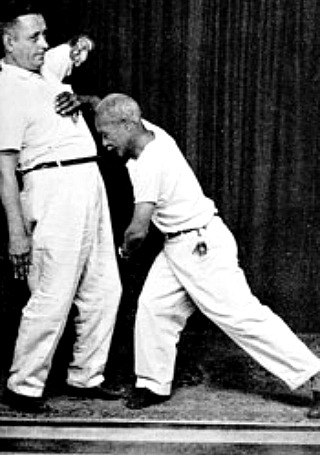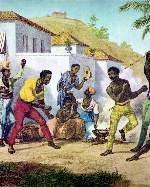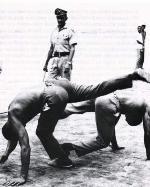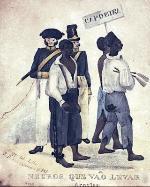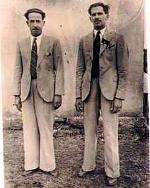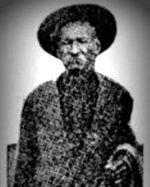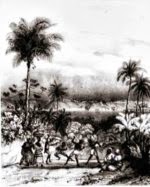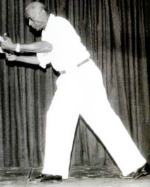Mestre Pastinha and Angola Capoeira
Talk the Talk
Though the two main styles of the art are Regional and Angola capoeira, in recent times some capoeiristas have blended the two and/or added
new movements to their arsenal.
Any style that does not strictly stick to the two main systems are commonly known as Capoeira Contemporânea and while frowned upon by some more traditional capoeira mestres, are seen by others as fundamental in the future evolution of capoeira.
Any style that does not strictly stick to the two main systems are commonly known as Capoeira Contemporânea and while frowned upon by some more traditional capoeira mestres, are seen by others as fundamental in the future evolution of capoeira.
Walk the Walk
Modern capoeira arts combine to provide what is thought of as a game with no winners or losers as such, just two players
demonstrating their skills, agility and control over their own bodies.
However, it should not be forgotten that the capoeira moves being practised are deadly techniques designed to hurt, subdue or even kill an opponent. As Mestre Pastinha put it, “What I do playing, you don't even do when you're mad".
However, it should not be forgotten that the capoeira moves being practised are deadly techniques designed to hurt, subdue or even kill an opponent. As Mestre Pastinha put it, “What I do playing, you don't even do when you're mad".
Capoeira Quote
"Sorcery of slaves longing for liberty, its beginning has no method and its end is inconceivable to the wisest capoeirista".
~ Mestre Pastinha ~
~ Mestre Pastinha ~
As a young boy growing up in early twentieth-century Brazil, Vicente Ferreira Pastinha learned martial arts to stop bullies from picking on him. He found an African Mestre known as Benedito to teach him the various aspects of the capoeira arts and within a short space of time, the bullies learned to leave him alone.
Mestre Pastinha and Angola. [Internet]. 2012. Rensselaer Polytechnic Institute. Available from: http://capoeira.union.rpi.edu/history.php?chapter=Pastinha [Accessed February 27, 2014].
Shrewd Game: Capoeira Angola. [Internet]. 2002. University of Florida. Available from: http://iml.jou.ufl.edu/projects/fall02/oliveira/angola.html [Accessed February 27, 2014].
What is Capoeira? [Internet]. 2013. Abolicao Oxford Capoeira. Available from: http://www.abolicao.co.uk/aboutcapoeira [Accessed February 27, 2014].
Mestre Pastinha soon became popular as he would demonstrate his newfound skills and teach capoeira to his school friends. This set the stage for him to later become one of the best martial arts instructors the country has ever seen, respected and loved by capoeiristas across Brazil.
Traditional Brazilian Capoeira
The history of Brazilian capoeira is a turbulent one and traditionally the art was illegal until the late 1920s, when it was legitimized by Mestre Bimba, who introduced a system known as Regional capoeira.However, Mestre Pastinha believed that the set sequences and training schedules taught in the Regional style detracted from the true spirit of capoeira, which was for each capoeirista to find his or her own style.
This was more akin to the type of fighting practised in the early history of the martial art when slaves used dance to hide the fact that they were practising deadly moves. The best way to become prolific, according to Mestre Pastinha, was simply to watch other capoeira fighters, to get into the thick of things and learn by trial and error.
The Rise of Mestre Pastinha
Mestre Pastinha’s way of teaching really began to gain recognition in 1942 when he led one of the ‘Sunda’ rodas at the Ladeira do Gengibirra. In the same year, the first modern Angola capoeira school, the Centro Esportivo de Capoeira Angola was opened, changing Brazilian capoeira forever.Written by Andrew Griffiths – Last updated 05/06/2023. If you like
what you see, consider following the History of Fighting on social media.
Further Reading:
Mestre Pastinha. [Internet]. 2008. Calunga. Available from: http://grupocalunga.blogspot.co.uk/p/mestre-pastinha.html [Accessed February 27, 2014].Mestre Pastinha and Angola. [Internet]. 2012. Rensselaer Polytechnic Institute. Available from: http://capoeira.union.rpi.edu/history.php?chapter=Pastinha [Accessed February 27, 2014].
Shrewd Game: Capoeira Angola. [Internet]. 2002. University of Florida. Available from: http://iml.jou.ufl.edu/projects/fall02/oliveira/angola.html [Accessed February 27, 2014].
What is Capoeira? [Internet]. 2013. Abolicao Oxford Capoeira. Available from: http://www.abolicao.co.uk/aboutcapoeira [Accessed February 27, 2014].
More Capoeira History
Capoeira History Home
An overview of the history of capoeira from its early roots, its development by slaves in Brazil, how it flourished amongst criminals and its further development and legitimisation by Mestre Bimba in the early twentieth century.
An overview of the history of capoeira from its early roots, its development by slaves in Brazil, how it flourished amongst criminals and its further development and legitimisation by Mestre Bimba in the early twentieth century.
The Roots of Capoeira
The exact roots of capoeira are unknown and largely unstudied. This article explores the possible beginnings of capoeira history and looks at how and why it became a part of the culture amongst Brazilian slaves from the sixteenth century onward.
The exact roots of capoeira are unknown and largely unstudied. This article explores the possible beginnings of capoeira history and looks at how and why it became a part of the culture amongst Brazilian slaves from the sixteenth century onward.
Brazil’s Criminal Underworld
From the late 19th century, the criminal underworld of Brazil saw its numbers dramatically rise when slavery legally came to an end in 1888. Many skilled fighters became powerful and as many of them were capoeirista, the martial art became synonymous with criminal gangs.
From the late 19th century, the criminal underworld of Brazil saw its numbers dramatically rise when slavery legally came to an end in 1888. Many skilled fighters became powerful and as many of them were capoeirista, the martial art became synonymous with criminal gangs.
Mestre Manduca da Praia – The Elegant Capoeira Fighter
Mestre Manduca da Praia, known as ‘The Elegant Capoeira Fighter’ was a nineteenth century Brazilian martial artist who was not only a ferocious warrior, but managed to maintain his standing as a respectable business man with in his community.
Mestre Manduca da Praia, known as ‘The Elegant Capoeira Fighter’ was a nineteenth century Brazilian martial artist who was not only a ferocious warrior, but managed to maintain his standing as a respectable business man with in his community.
Jose Antonio do Nascimento
Jose Antonio do Nascimento was one of the best fighters of the nineteenth century. His skills earned him a fearsome reputation and his size and prowess earned him the nickname Nascimento Grande (Big Birth).
Jose Antonio do Nascimento was one of the best fighters of the nineteenth century. His skills earned him a fearsome reputation and his size and prowess earned him the nickname Nascimento Grande (Big Birth).
Mestre Besouro Manganga
Besouro Manganga was such a prolific capoeira fighter that people believed him to have magical powers (known as corpo fechado). His agility and nimbleness helped him avoid capture time and time again, and even when cornered by police, he would usually come out on top.
Besouro Manganga was such a prolific capoeira fighter that people believed him to have magical powers (known as corpo fechado). His agility and nimbleness helped him avoid capture time and time again, and even when cornered by police, he would usually come out on top.
Mestre Bimba
Mestre Bimba is important in capoeira history because of the role he played in legitimizing the art. By introducing a code of ethics, set training methods and a number of new techniques, he helped change capoeira from an illegal discipline associated with crime, to an iconic cultural pastime.
Mestre Bimba is important in capoeira history because of the role he played in legitimizing the art. By introducing a code of ethics, set training methods and a number of new techniques, he helped change capoeira from an illegal discipline associated with crime, to an iconic cultural pastime.
The images on this site are believed to be in the public domain, however, if any mistakes have been made and your copyright or intellectual rights have been breeched, please contact andrew@articlesonhistory.com.

